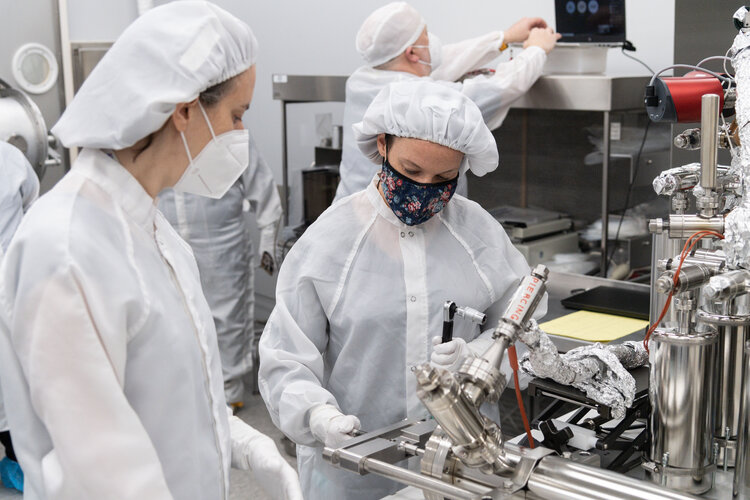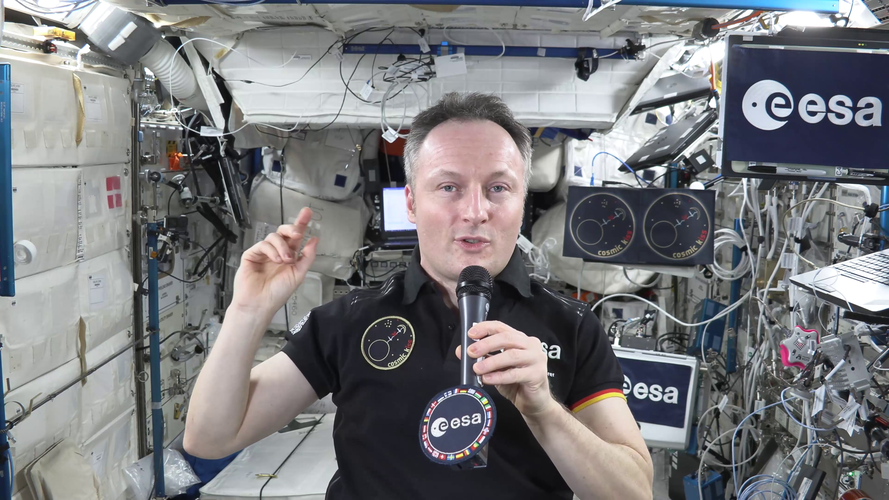
Copernical Team
Industry Space Days 2022: join Europe’s space community at ESA/ESTEC

Register now to attend ESA’s Industry Space Days (ISD) at the European Space Research and Technology Centre (ESTEC) in Noordwijk, the Netherlands, on 28–29 September 2022.
Pop goes the Moon
 Image:
Image:
A satisfying, audible ‘pop’ marked a successful piercing of the sealed Apollo 17 sample container using the ESA designed and built piercing tool. The tool forms part of a gas sampling system with a gas extraction manifold, designed and built by Washington University St Louis, USA.
Francesca McDonald, science and project lead of ESA’s contribution to the Apollo Next-Generation Sample Analysis (ANGSA) programme, is pictured at the centre of this image with the piercing tool, which contains the pristine sample.
Francesca and colleague, Timon Schild, delivered the ESA piercing tool to NASA’s Johnson Space Center in late 2021 in preparation
Join online: Earth Observation Industry Day 13 May

Earth Observation Industry Day
Join online and learn about ESA's Ministerial Council plans for TRUTHS and FutureEO, 13 May
Matthias's first spacewalk | Cosmic Kiss
 Video:
00:16:36
Video:
00:16:36
English Matthias's first spacewalk | Cosmic Kiss
On 23 March 2022, ESA astronaut Matthias Maurer successfully performed his first extravehicular activity (EVA) alongside fellow NASA astronaut Raja Chari. The spacewalk, dubbed "US EVA 80", was carried out in support of assembly, refurbishment and maintenance work on the International Space Station.
In this video, Matthias Maurer answers questions and reports on his experiences, feelings and the challenges he faced during his almost seven-hour-long spacewalk.
During his Cosmic Kiss mission, Matthias Maurer will live and work aboard the International Space Station for approximately six months, conducting and supporting more than 35 European
Orbital Assembly and Irvine to study health on ISS for 100 Year Starship project
 Orbital Assembly Corporation (OAC), the only company advancing the development and operation of the first commercially viable, space-based business park with gravity, is partnering with the 100 Year Starship initiative, seed-funded by DARPA, founded and led former astronaut Dr. Mae Jemison. University of California Irvine professor Ronke Olabisi, Ph.D. will also collaborate on the study of Gravi
Orbital Assembly Corporation (OAC), the only company advancing the development and operation of the first commercially viable, space-based business park with gravity, is partnering with the 100 Year Starship initiative, seed-funded by DARPA, founded and led former astronaut Dr. Mae Jemison. University of California Irvine professor Ronke Olabisi, Ph.D. will also collaborate on the study of Gravi Intelsat supports programmers with cloud connect media
 Intelsat - operator of the world's largest integrated satellite and terrestrial network and a leading provider of inflight connectivity (IFC) - has announced its latest service offering: Cloud Connect Media, a connectivity solution that provides programmers with secure access between the IntelsatOne Media Network and Amazon Web Services (AWS).
Cloud Connect Media is designed to provide con
Intelsat - operator of the world's largest integrated satellite and terrestrial network and a leading provider of inflight connectivity (IFC) - has announced its latest service offering: Cloud Connect Media, a connectivity solution that provides programmers with secure access between the IntelsatOne Media Network and Amazon Web Services (AWS).
Cloud Connect Media is designed to provide con Tianzhou 4's rocket arrives in Hainan
 The Long March 7 carrier rocket tasked with launching the Tianzhou 4 cargo spacecraft arrived at Wenchang Space Launch Center in Hainan province on Monday, the China Manned Space Agency said.
Next, the rocket will be assembled and undergo ground tests with the robotic spaceship at the coastal launch complex, the agency said in a brief statement.
Tianzhou 4, the country's fourth cargo
The Long March 7 carrier rocket tasked with launching the Tianzhou 4 cargo spacecraft arrived at Wenchang Space Launch Center in Hainan province on Monday, the China Manned Space Agency said.
Next, the rocket will be assembled and undergo ground tests with the robotic spaceship at the coastal launch complex, the agency said in a brief statement.
Tianzhou 4, the country's fourth cargo Swiftly gaining holistic views of space systems with AI
 As Lockheed Martin designs and tests spacecraft, massive amounts of data points are created and it's important to review that information to pinpoint any anomalies. That process could be extremely time consuming without the right tools in place, like artificial intelligence (AI) technology.
For years, Lockheed Martin has incorporated NEC Corporation's System Invariant Analysis Technology (
As Lockheed Martin designs and tests spacecraft, massive amounts of data points are created and it's important to review that information to pinpoint any anomalies. That process could be extremely time consuming without the right tools in place, like artificial intelligence (AI) technology.
For years, Lockheed Martin has incorporated NEC Corporation's System Invariant Analysis Technology ( Kleos' first two Patrol satellites deployed from D-Orbit Transfer vehicle
 Kleos Space S.A (ASX:KSS, Frankfurt:KS1) has confirmed that the first two Patrol Mission satellites (KSF2-C and KSF2-D) have been successfully deployed from D-Orbit's orbital transfer vehicle, ION Satellite Carrier, and contact has been established. The remaining two Patrol satellites (KSF2-A and KSF3-B) are expected to be deployed into a different orbit from the transfer vehicle in the coming w
Kleos Space S.A (ASX:KSS, Frankfurt:KS1) has confirmed that the first two Patrol Mission satellites (KSF2-C and KSF2-D) have been successfully deployed from D-Orbit's orbital transfer vehicle, ION Satellite Carrier, and contact has been established. The remaining two Patrol satellites (KSF2-A and KSF3-B) are expected to be deployed into a different orbit from the transfer vehicle in the coming w Race is on for China's first domestic satellite listed firm
 China's commercial aerospace sector has embraced a wave of IPO plans recently, as private enterprises hasten to "aim for the stars" and become the country's first domestically listed aerospace company.
In March, Chang Guang Satellite Technology Co, the country's first commercial remote sensing satellite firm, is planning to file an IPO, according to the website of Haitong Securities.
China's commercial aerospace sector has embraced a wave of IPO plans recently, as private enterprises hasten to "aim for the stars" and become the country's first domestically listed aerospace company.
In March, Chang Guang Satellite Technology Co, the country's first commercial remote sensing satellite firm, is planning to file an IPO, according to the website of Haitong Securities. 